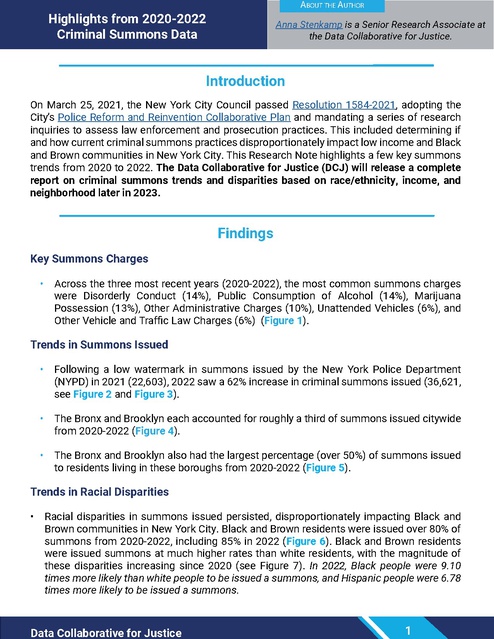Highlights From 2020-2022 Criminal Summons Data
Download original document:

Document text

Document text
This text is machine-read, and may contain errors. Check the original document to verify accuracy.
About the Author Highlights from 2020-2022 Criminal Summons Data Anna Stenkamp is a Senior Research Associate at the Data Collaborative for Justice. Introduction On March 25, 2021, the New York City Council passed Resolution 1584-2021, adopting the City’s Police Reform and Reinvention Collaborative Plan and mandating a series of research inquiries to assess law enforcement and prosecution practices. This included determining if and how current criminal summons practices disproportionately impact low income and Black and Brown communities in New York City. This Research Note highlights a few key summons trends from 2020 to 2022. The Data Collaborative for Justice (DCJ) will release a complete report on criminal summons trends and disparities based on race/ethnicity, income, and neighborhood later in 2023. Findings Key Summons Charges • Across the three most recent years (2020-2022), the most common summons charges were Disorderly Conduct (14%), Public Consumption of Alcohol (14%), Marijuana Possession (13%), Other Administrative Charges (10%), Unattended Vehicles (6%), and Other Vehicle and Traffic Law Charges (6%) (Figure 1). Trends in Summons Issued • Following a low watermark in summons issued by the New York Police Department (NYPD) in 2021 (22,603), 2022 saw a 62% increase in criminal summons issued (36,621, see Figure 2 and Figure 3). • The Bronx and Brooklyn each accounted for roughly a third of summons issued citywide from 2020-2022 (Figure 4). • The Bronx and Brooklyn also had the largest percentage (over 50%) of summons issued to residents living in these boroughs from 2020-2022 (Figure 5). Trends in Racial Disparities • Racial disparities in summons issued persisted, disproportionately impacting Black and Brown communities in New York City. Black and Brown residents were issued over 80% of summons from 2020-2022, including 85% in 2022 (Figure 6). Black and Brown residents were issued summons at much higher rates than white residents, with the magnitude of these disparities increasing since 2020 (see Figure 7). In 2022, Black people were 9.10 times more likely than white people to be issued a summons, and Hispanic people were 6.78 times more likely to be issued a summons. Data Collaborative for Justice 1 Trends in Racial Disparities and Income • Lower income New Yorkers were issued more summons than higher income New Yorkers, with over 61% of summons issued to those who are below the median household income of New York City ($70,663) (Figure 9). • When analyzing summons issued based on median household income according to the census, regardless of income, Black and Brown New Yorkers were disproportionately issued summonses compared to white New Yorkers (Figure 10). Figure 1. Top Summons Charges (2020-2022) Summons Charge Percent of Total Disorderly Conduct (PL 240.20) 14% Public Consumption of Alcohol (AC 10-125) I 14% Marijuana Possession (PL 221.05) 13% Other Administrative Code Charges (25 AC) I 10% Unattended Vehicle (AC 10-111) 6% Other Vehicle and Traffic Law (62 VTL) 16% All Other Charaes 37% Figure 2. Summons Issued: 2013-2022 400000 350000 Criminal Justice Reform Act (CJRA) became law June 2016 300000 250000 200000 150000 100000 50000 0 2013 2014 2015 2016 2017 2018 2019 2020 2021 2022 Note: The CJRA moved many criminal summons cases to the civil justice system. Data Collaborative for Justice 2 Figure 3. Summons Issued: 2021-2022 40,000 35,000 30,000 +62% 25,000 20,000 15,000 10,000 5,000 0 2021 2022 Figure 4. Percentage of Summons Issued by Borough of Issuance, 2020-2022 100% - · ro- 90% _ , o.._ 17% 80% 19% 70% 60% 50% 40% 30% 20% 10% 0% 2020 ■ Bronx 2021 ■ Brooklyn Data Collaborative for Justice ■ Manhattan 2022 ■ Queens ■ Staten Island 3 Figure 5. Percentage of Summons Issued by Borough of Residence of the Charged Individual, 2020-2022 100% 90% 80% 70% 60% 50% 40% 30% 20% 10% 0% 2020 ■ Bronx ■ Brooklyn 2021 ■ Manhattan 2022 ■ Queens ■ Staten Island ■ Outside of NYC Figure 6. Percentage of Summons Issued by Race/Ethnicity, 2020-2022 100% 5% 90% 6% ... . I'' 80% 70% 60% 50% 40% 30% 20% 10% 0% 2020 ■ Black ■ Hispanic 2021 ■ White ■ Asian 2022 ■ Additional Racial/Ethnic Groups *Note: Additional Racial/Ethnic Groups (green bars) each = 1%. Data Collaborative for Justice 4 Figure 7. Higher Rate of Summons Issued for Black and Hispanic People Compared to White People (Relative to Their General Population Numbers) 12.00 9.83 9.10 10.00 8.00 6.78 6.06 6.00 4.00 2.00 0.00 2020 - Black/white 2021 - 2022 Hispanic/white Note: This only includes New York City residents over the age of 18. Figure 8. 2020 Pandemic-Related Charges vs. All Other Charges by Race and Ethnicity 60% 50% 51% 40% 30% 36... 135% 30-.. 20% 2s-.. 10% 9% 0% Black Hispanic ■ White Pandemic-Related Charges Data Collaborative for Justice I '" 5%7 Asian ■ All Other Charges 1% 1% Additional Racial/Ethnic Groups 5 Figure 9. Summons Issued by Household Income 45% 40% 35% 30% 25% 20% 15% 10% 5% 0% $15,000-$34,999 $35,000-$49,999 $50,000-$74,999 $75,000-$99,999 ■ 2020 ■ 2021 ■ $100,000 + 2022 Figure 10: 2022 Summons Issued by Race/Ethnicity and Income 60% 52% 50% 40% 30% 20% 10% 0% $15,000-$34,999 ■ Black $35,000-$49,999 ■ Hispanic Data Collaborative for Justice ■ White $50,000-$74,999 ■ Asian ■ $75,000-$99,999 $100,000 + Additional Racial/Ethnic Groups 6

